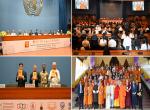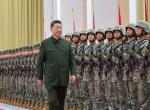The country is amid an unprecedented pandemic that has taken a heavy toll on life which exceeds that in all the wars that India has been involved in in the last 100 years. The crisis has to be dealt with on a war footing.
The infection is now spreading to rural areas. Vaccination is the last tool we have to break the transmission of the virus. While the vaccination of over 18 crore people in an organised manner is creditable, the country’s needs are stupendous. The vaccination strategy should be geared towards the universal vaccination of the entire population in a short time. Door to door vaccination may be the answer once vaccines become available. If we have to live with the pandemic, as seems to be the case, we will have to develop new vaccines and vaccinate the entire population regularly. Fresh thinking is required on the vaccination front.
A group of experts from business, industry, disaster management disciplines and the strategic community met at the VIF virtually on 14 may 2021 to discuss the possible vaccine strategy in the backdrop of the Second Covid-19 wave. A few recommendations and suggestions that emerged from the discussion are listed below for consideration.
- Vaccine Production
Any effective vaccine strategy will hinge on the adequate availability of vaccine either through domestic production or imports. Indigenous production is the most important element as there are worldwide shortages and imports may not always be possible.
The government has assured that by the end of the year 216 crore vaccines would be available. This is indeed welcome news but also a difficult though not an impossible task. The existing production will have to be ramped up several times and new manufacturing capacities would have to be set up. Some of the vaccines are still in trial mode. It is necessary that the government should closely monitor the progress and persuade the manufacturers to stick to strict timelines to avoid disappointment later.
A task force consisting of the representatives of the government representatives and potential manufacturers to identify the likely issues which may hinder the prediction in a timely manner needs to be formed. The government should look into the issues of finance, technology, IPRs, manpower, facilitation, supply chains etc to ensure that the production plan is adhered to. This will require detailed planning and execution.
India is a huge market for vaccines and is likely to remain so in the near future. New mutants are likely to emerge. The existing vaccines may have to be tweaked. New vaccines may be needed. We will need to invest in R&D. Thus there is a need to focus on the vaccines in a comprehensive way.
This opportunity should be used to revitalise the domestic vaccine manufacturing ecosystem and strengthening the Make-in-India programme for vaccines and other associated ancillaries. A task force may be set up to plan for the next five years. The Production Linked Incentivisation (PLI) scheme can be utilised to create incentives.
India cannot overlook the export and imports. Many raw materials and other products would have to be imported. There are import restrictions. The government would have to be proactive to ensure that supply chains are not disrupted. Active diplomacy will be required.
As India is the world’s largest vaccine manufacturing centre, the world will look towards India for the supply of vaccines. The pandemic has to be fought jointly with other countries. Thus, India should produce for domestic consumption as well as for exports.
Continued Centralisation of Vaccine Procurement – Given the current scarcity in the supply of vaccines as well as the time that will take for India to enhance this capacity either by way of domestic manufacturing or imports - we suggest the Centre taking back the control on procurement and distribution of vaccines - that the Centre procure all vaccines from all channels possible, allocate equitably basis the surge in infection rates for different states and then direct States to further disburse these to private providers operating in respective States.
A direct approach by various entities to vaccine manufacturers may lead to the concentration of supplies with a few vaccinating agencies. The mode of supplying doses through the administration would ensure that all healthcare providers can access the vaccines in all parts of the country. All entities, including private healthcare providers, could make their requirements known to the district authorities and collect the doses as allocated.
In principle, the procurement price of vaccines for central and state governments should be fixed at the same amount. For non-government entities, there may be a differential price as deemed appropriate by the Government.
A predictable and equitable supply for all districts may be prioritized as per a pre-determined formula which could be based on suggestions by experts.
We also, therefore, suggest that the government once again put a cap on the maximum administrative fee that private providers can charge otherwise this will create another false shortage with access to vaccines for only those that can afford it - which would not serve the overall purpose of inoculating the largest available adult population.
We further suggest that as CoWIN app may not be available to all, walk-in registrations for all adults should be permitted. Towards facilitating as many of the adult Indian population to be vaccinated, we recommend the Government to consider permissions to operate Mobile Vaccine Vans to reach the last mile as well as allow Indian Health Tech Companies to mobilize home vaccination services.
Vaccination points need to be multiplied manyfold. As the vaccine shortages abate, door-to-door vaccination may also be aimed at. We also need to quickly create the human resources needed for vaccination. A taskforce may be set up to look at the human resources required had how to mobilise and organise human resources in large numbers. The help of the armed forces, civil defence organisations, paramilitary forces, territorial army etc may be taken.
We also request a central Asset Mapping Control Team be created for purposes of monitoring the supply of various Essential Critical Care Items as well as predicting possible occurrences of shortages and pre-emptively enhancing respective State Capacity which would require Logistic as well as Transport facilitation.
We did relatively well in the first wave. A vaccine was invented. Indigenous production started. But, the second wave has turned out to be much more virulent than the first. A third wave is expected. The virus may change its nature. All sections of the population are vulnerable. This is the time to focus on vaccine development, production, distribution and delivery. We cannot vaccine inequity. We need to devise a comprehensive strategy for vaccines.
(The paper is the author’s individual scholastic articulation. The author certifies that the article/paper is original in content, unpublished and it has not been submitted for publication/web upload elsewhere, and that the facts and figures quoted are duly referenced, as needed, and are believed to be correct). (The paper does not necessarily represent the organisational stance... More >>
Image Source: https://www.indiatvnews.com/news/india/covid19-vaccines-in-india-covishield-covaxin-sputnik-v-emergency-use-coronavirus-dcgi-697534










Post new comment